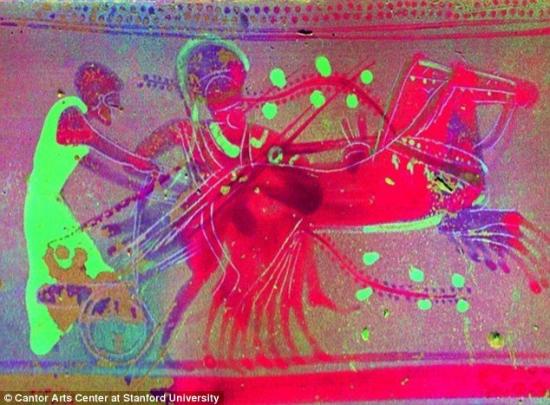Shivali Best
Source - http://www.dailymail.co.uk/sciencetech/article-3837808/Secrets-Greek-artist-s-revealed-X-rays-hidden-colours-used-stunning-2-500-year-old-vase.html#ixzz4NAADjaIo
 The study focused on an Athenian oil-flask, called a lekythos from 500-480 BC
The study focused on an Athenian oil-flask, called a lekythos from 500-480 BC
Researchers have used a new x-ray scanning technique on an ancient Greek vase to reveal layers of hidden paint beneath the surface.
The results raise questions about how ancient pottery was produced, and whether previously unknown additional steps were involved.
The researchers now hope to use the x-ray scanning method on other materials that could be used in batteries or electronics.

 The chemical map shows calcium (green) matching the white areas in the driver's tunic and dot accents, and iron (red) and potassium (blue) matching the black of the horse and figure silhouettes.
The chemical map shows calcium (green) matching the white areas in the driver's tunic and dot accents, and iron (red) and potassium (blue) matching the black of the horse and figure silhouettes.
The findings come as a result of a growing collaboration between the Cantor Arts Centre and Stanford University, both in California.
About two years ago, the Arts Centre introduced a fellowship for science students interested in studying art conservation.
Susan Roberts-Manganelli, director of the Learning Lab said: 'We can do a lot of testing here at the Cantor.
'But some studies need more robust collaboration and more powerful X-rays to actually get answers to our questions.'
One such study, done by student Kevin Chow, took a deeper look at the techniques of the ancient Greek potters, which are difficult to reproduce and not entirely understood.
The study focused on an Athenian oil-flask, called a lekythos, from 500-480 BC.
Using a technique called synchrotron X-ray fluorescence, the team was able to uncover surprising steps in the production process that challenge the conventional understanding
 The scan produced a chemical map, which showed that a calcium-based colour additive was used for white, which would have added an additional step
The scan produced a chemical map, which showed that a calcium-based colour additive was used for white, which would have added an additional step
Jody Maxim, who supervised Mr Chow's study, said: 'Under what they thought was a single coat, they found other instances of painting that the naked eye could not see.
'It was thrilling to learn that a very humble vase - hundreds of these were produced for the Festival of Athena every four years - shows certain standards of aesthetic excellence.'
The scan produced a chemical map, which showed that a calcium-based colour additive was used for white, which would have added an additional step.
It also raised questions about the firing process, due to the absence of zinc – which was presumed to be key in achieving black colours in the heating process.
The researchers now hope to use the same scanning technique on other materials.
Apurva Mehta, a scientist from Stanford, said: 'We had to find a way to see all layers of the Greek pot in detail, which is something we want to do for other materials that might be used in batteries or electronics.'
WHAT DID THE SCAN SHOW?
Using a technique called synchrotron X-ray fluorescence, the team was able to uncover surprising steps in the production process that challenge the conventional understanding.
Jody Maxim, who supervised Mr Chow's study, said: 'Under what they thought was a single coat, they found other instances of painting that the naked eye could not see.
'It was thrilling to learn that a very humble vase - hundreds of these were produced for the Festival of Athena every four years - shows certain standards of aesthetic excellence.'
The scan produced a chemical map, which showed that a calcium-based colour additive was used for white, which would have added an additional step.
It also raised questions about the firing process, due to the absence of zinc – which was presumed to be key in achieving black colours in the heating process.